 Five years after it opened, the Marina Bay Sands (MBS) integrated resort casino has become one of the Singapore skyline’s most distinguishable features.
Five years after it opened, the Marina Bay Sands (MBS) integrated resort casino has become one of the Singapore skyline’s most distinguishable features.
MBS, which opened its doors on April 27, 2010, cost $5.7b to build and generated $1.7b in earnings for Las Vegas Sands in 2014. The property’s success story has made it the first stop for legislators from other jurisdictions that are considering opening up their casino markets.
Perhaps even more importantly to Sands boss Sheldon Adelson, MBS has become an iconic facility, infinitely more recognizable than its crosstown rival, Genting Singapore’s Resorts World Sentosa (RWS).
Genting Singapore held its annual general meeting last week, and its lack of visual appeal was a far less pressing concern than its growing bad debt problem. The amount of bad debts at RWS grew nearly 42% last year to US $262m – 13.3% of its total VIP revenue – prompting chairman Lim Kok Thay to proclaim that the company had since become a little more discerning in choosing who gets credit.
Lim assured shareholders that some of this debt would eventually be recovered and said the debt provision demonstrated the company was taking a “more prudent” approach than their competition. “It is the legacy of the Genting group; we’ve always provided prudently, so that we can sleep better at night, in case a nuclear bomb falls.”
Maybank Kim Eng Research recently issued a note saying that while RWS was embracing its newfound stinginess with credit, rival MBS was increasing its rebate rate, allowing it to poach VIP market share. Genting Singapore has yet to report its Q1 figures but Maybank believes that RWS’ share of Singapore’s VIP market fell to 50% from 54% in Q4 while MBS’ VIP business held firm over the same period. Happy birthday, MBS.
